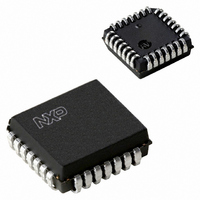SCC2691AC1A28,602 NXP Semiconductors, SCC2691AC1A28,602 Datasheet - Page 19

SCC2691AC1A28,602
Manufacturer Part Number
SCC2691AC1A28,602
Description
IC UART SINGLE 28-PLCC
Manufacturer
NXP Semiconductors
Datasheet
1.SCC2691AC1A28623.pdf
(25 pages)
Specifications of SCC2691AC1A28,602
Features
False-start Bit Detection
Number Of Channels
1, UART
Fifo's
3Bit
Voltage - Supply
5V
With Auto Flow Control
Yes
With False Start Bit Detection
Yes
With Cmos
Yes
Mounting Type
Surface Mount
Package / Case
28-PLCC
Lead Free Status / RoHS Status
Lead free / RoHS Compliant
Other names
568-1212-5
933811550602
SCC2691AC1A28
933811550602
SCC2691AC1A28
Available stocks
Company
Part Number
Manufacturer
Quantity
Price
Company:
Part Number:
SCC2691AC1A28,602
Manufacturer:
NXP Semiconductors
Quantity:
10 000
Philips Semiconductors
The CTS, RTS, CTS Enable Tx signals
CTS (Clear To Send) is usually meant to be a signal to the
transmitter meaning that it may transmit data to the receiver. The
CTS input is on pin MPI. The CTS signal is active low; thus, it is
called CTSN.
RTS is usually meant to be a signal from the receiver indicating that
the receiver is ready to receive data. It is also active low and is,
thus, called RTSN. RTSN is on pin MP0. A receiver’s RTS output
will usually be connected to the CTS input of the associated
transmitter. Therefore, one could say that RTS and CTS are
different ends of the same wire!
MR2(4) is the bit that allows the transmitter to be controlled by the
CTS pin (MPI). When this bit is set to one AND the CTS input is
driven high, the transmitter will stop sending data at the end of the
present character being serialized. It is usually the RTS output of
the receiver that will be connected to the transmitter’s CTS input.
The receiver will set RTS high when the receiver FIFO is full AND
the start bit of the fourth character is sensed. Transmission then
stops with four valid characters in the receiver. When MR2(4) is set
to one, CTSN must be at zero for the transmitter to operate. If
MR2(4) is set to zero, the MP pin will have no effect on the operation
of the transmitter.
MR1(7) is the bit that allows the receiver to control MP0. When MP0
is controlled by the receiver, the meaning of that pin will be RTS.
However, a point of confusion arises in that MP0 may also be
controlled by the transmitter. When the transmitter is controlling this
pin, its meaning is not RTS at all. It is, rather, that the transmitter
has finished sending its last data byte. Programming the MP0 pin to
be controlled by the receiver and the transmitter at the same time is
allowed, but would usually be incompatible.
2006 Aug 04
TRANSMITTER
ENABLED
Universal asynchronous receiver/transmitter (UART)
RDN/WRN
(WRITE]
ENABLED
RECEIVER
TxRDY
CSN
(SR0)
(SR2)
RxRDY
RxD
TxD
MR1[4:3] = 11
PERIPHERAL STATION
MASTER STATION
MR1[4:3] = 11
MR1[2] = 1
ADD#1 MR1[2] = 0 D0
0
BIT 9
ADD#1
BIT 9
1
ADD#1
1
BIT 9
D0
BIT 9
ADD#1
Figure 12. Wake-Up Mode
0
D0
0
BIT 9
19
MR1[2] = 1 ADD#2
RTS can also be controlled by the commands 1010 and 1011 in the
command register. RTS is expressed at the MP0 pin which is still an
output port. Therefore, the state of MP0 should be set low (by
commands to the CR register) for the receiver to generate the
proper RTS signal. The logic at the output is basically a NAND of
the MP0 bit register and the RTS signal as generated by the
receiver. When the RTS flow control is selected via the MR(7) bit
the state of the MP0 register is not changed. Terminating the use of
“Flow Control” (via the MR registers) will return the MP0 pin to the
control of the MP0 register.
Transmitter Disable Note
The sequence of instructions enable transmitter — load transmit
holding register — disable transmitter will result in nothing being
sent if the time between the end of loading the transmit holding
register and the disable command is less that 3/16 bit time in the
16x mode or one bit time in the 1x mode. Also, if the transmitter,
while in the enabled state and underrun condition, is immediately
disabled after a single character is loaded to the transmit holding
register, that character will not be sent.
In general, when it is desired to disable the transmitter before the
last character is sent AND the TxEMT bit is set in the status register
(TxEMT is always set if the transmitter has underrun or has just
been enabled), be sure the TxRDY bit is active immediately before
issuing the transmitter disable instruction. TxRDY sets at the end of
the “start bit” time. It is during the start bit that the data in the
transmit holding register is transferred to the transmit shift register.
Non-standard baud rates are available as shown in Table 6 below,
via the BRG Test function.
S
D0
D
S = STATUS
D = DATA
ADD#2
BIT 9
1
ADD#2
1
BIT 9
S
ADD#2
SCC2691
Product data sheet
D
BIT 9
0
SD00130















